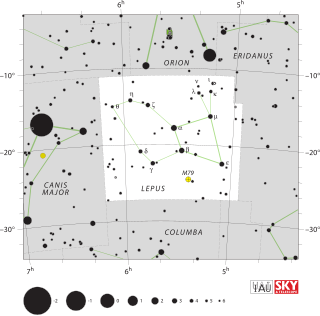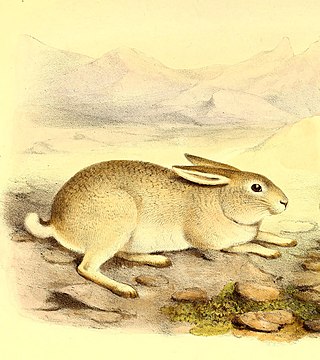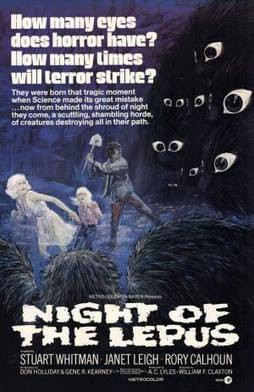Lepus is a genus of mammals in the family Leporidae.
Lepus may also refer to:
- Lepus (constellation)
- Amnirana lepus , a species of frog
- Arieșeni (Hungarian: Lepus), a commune in Romania
- Mount Lepus, a massif in Antarctica
Lepus is a genus of mammals in the family Leporidae.
Lepus may also refer to:

Lepus is a constellation lying just south of the celestial equator. Its name is Latin for hare. It is located below—immediately south—of Orion, and is sometimes represented as a hare being chased by Orion or by Orion's hunting dogs.

Hares and jackrabbits are mammals belonging to the genus Lepus. They are herbivores, and live solitarily or in pairs. They nest in slight depressions called forms, and their young are able to fend for themselves shortly after birth. The genus includes the largest lagomorphs. Most are fast runners with long, powerful hind legs, and large ears to dissipate body heat. Hare species are native to Africa, Eurasia and North America. A hare less than one year old is called a "leveret". A group of hares is called a "husk", a "down", or a "drove".

Leporidae is the family of rabbits and hares, containing over 70 species of extant mammals in all. The Latin word Leporidae means "those that resemble lepus" (hare). Together with the pikas, the Leporidae constitute the mammalian order Lagomorpha. Leporidae differ from pikas in that they have short, furry tails and elongated ears and hind legs.

The mountain hare, also known as blue hare, tundra hare, variable hare, white hare, snow hare, alpine hare, and Irish hare, is a Palearctic hare that is largely adapted to polar and mountainous habitats.

The Arctic hare is a species of hare highly adapted to living in the Arctic tundra and other icy biomes. The Arctic hare survives with shortened ears and limbs, a small nose, fat that makes up close to 20% of its body, and a thick coat of fur. It usually digs holes in the ground or under the snow to keep warm and to sleep. Arctic hares look like rabbits but have shorter ears, are taller when standing, and, unlike rabbits, can thrive in extreme cold. They can travel together with many other hares, sometimes huddling with dozens or more, but are usually found alone, sometimes taking more than one partner. The Arctic hare can run up to 60 kilometres per hour (40 mph).

The European hare, also known as the brown hare, is a species of hare native to Europe and parts of Asia. It is among the largest hare species and is adapted to temperate, open country. Hares are herbivorous and feed mainly on grasses and herbs, supplementing these with twigs, buds, bark and field crops, particularly in winter. Their natural predators include large birds of prey, canids and felids. They rely on high-speed endurance running to escape predation, having long, powerful limbs and large nostrils.
Brown hare may refer to:
M79 or M-79 may refer to:

The Cape hare, also called the brown hare and the desert hare, is a hare native to Africa and Arabia extending into India.

The Indian hare, also known as the black-naped hare, is a common species of hare native to the Indian subcontinent, and Java.

The Manchurian hare is a species of hare found in northeastern China and Russia, the Amur River basin, and the higher mountains of northern North Korea. It lives in forests and the IUCN has assessed its conservation status as being of "least concern".

The Yunnan hare is a medium-sized species of mammal in the family Leporidae. It has soft, flat, and long dorsal pelage which is grayish brown or dark gray in color, and whitish ventral pelage. It was considered endemic to China, but its presence was recorded in northern Myanmar in 2000. It is a herbivore, and forages on shrubs and forbs. It is rated as a species of least concern on the IUCN Red List of Endangered Species. The Red List of China's Vertebrates has listed the Yunnan hare as near threatened, almost meeting the criteria to be listed as vulnerable.

The Alaskan hare, also known as the tundra hare, is a species of mammal in the family Leporidae. They do not dig burrows and are found in the open tundra of western Alaska and the Alaska Peninsula in the United States. They are solitary for most of the year except during mating season, when they produce a single litter of up to eight young. Predators include birds of prey and polar bears, as well as humans.

The Chinese hare is a species of mammal in the family Leporidae. It is found in China, Taiwan and Vietnam.

The Yarkand hare is a species of mammal in the family Leporidae. It has soft, straight, sandy brown dorsal pelage which has grayish-black stripes, and completely white ventral pelage. Endemic to China, the Yarkand hare is restricted to the Tarim Basin in Southern Xinjiang, China. It is mainly nocturnal, and forages on grass and crops. The female produces two or three litters annually, each consisting of two to five young. It is rated as near threatened on the International Union for Conservation of Nature Red List of Endangered Species and by the Red List of China's Vertebrates. However, Chinese geneticists have stated the species is "endangered" due to limited habitat and its fragmentation, and over-hunting and poaching.
Snow bunny may refer to:

Night of the Lepus is a 1972 American science fiction horror film directed by William F. Claxton and produced by A. C. Lyles. Based upon Russell Braddon's 1964 science fiction novel The Year of the Angry Rabbit, the plot concerns an infestation of mutated rabbits.
Desert hare may refer to: